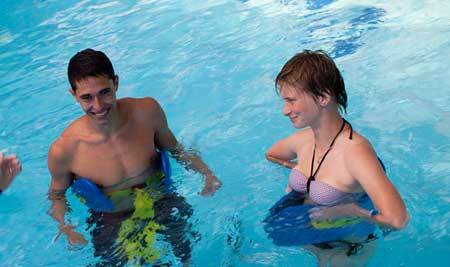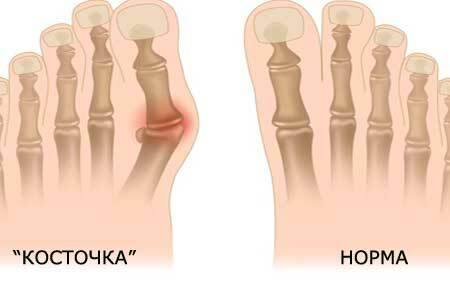The spine of a man is a unique engineering and technical structure of nature. Only a person walks on two legs, releasing limbs for work. Something similar was for two-legged dinosaurs, but they had a powerful tail, and the structure of the spine was completely different.
The task of the human spinal column is, in addition to the support function and the basis of the skeleton, depreciation. The main thing is not to "shake off" the skull and the brain located in it.
We are used to the fact that there is nothing surprising in this. But try driving on a bumpy road at high speed on a cart with wooden wheels bounded by iron, and you will appreciate the entire comfort of inflatable tires. Similarly, the vertebral column. It has several mechanisms for pulse suppression and depreciation:
- arch of the foot;
- physiological curves of the spine - lordosis and kyphosis;
- intervertebral elastic discs.
What is lordosis? This is the name of the physiological bending of the spine in the sagittal plane, convex curved posteriorly. Let's look more closely in this term, as well as in the causes of the violation of the lordosis of the spine.
Contents of
- 1 Lordsian - what is it?
- 2 Cervical lordosis
- 2.1 Classification of lordosis of the cervical spine
- 3 Symptoms of cervical lordosis
- 4 Lumbar lordosis
- 5 Treatment of cervical and lumbar lordosis - drugs and methods
- 5.1 Complications of lordosis
- 6 Prophylaxis
What is lordosis?
If you put a person directly in front of you, and then draw an imaginary plane so that this plane accurately divides the human body into the left and right imaginary half, then this plane will be the sagittal plane, from the lat. Sagitta is an arrow. In the sagittal plane, we see the image of the spine "in profile".
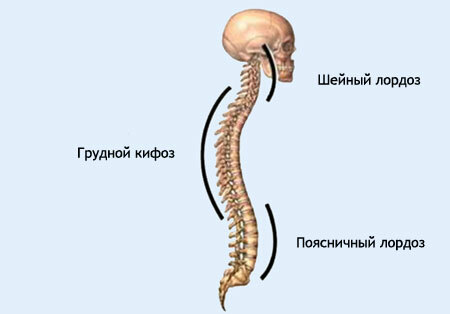
It is a bit like the mathematical sign of the integral, or the Latin letter "S".The spine forms physiological curves: lumbar lordosis, then thoracic kyphosis, and then again cervical lordosis.
A lordosis is a physiological curve of the spine, convex curved posteriorly. Normally, he is in the lumbar and cervical spine.
These two lordosis are separated by the kyphosis of the thoracic region, which is a long arc, convex toward the front. Physiological bends are formed together with the growth of the spine, and can vary depending on the disorders of posture.
For example, lordosis in children, as well as kyphosis, may be incomplete, curved in other planes, or, conversely, expressed excessively. With subsequent growth and development there is a persistent violation of posture, which can cause various symptoms.
This change in physiological lordosis, both in children and adults, is also called pathological, or simply lordosis.
Cervical lordosis
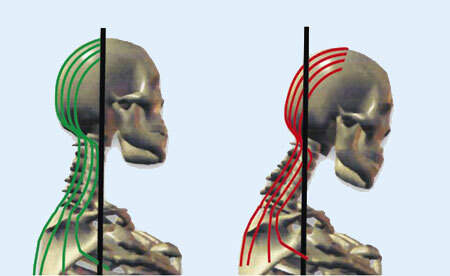
In this section we will talk about the pathological deformation of cervical lordosis. It can be both in utero and already acquired after delivery. Acquired cervical lordosis occurs for the following reasons:
- Various traumatic lesions of the cervical spine( dislocations, compression fractures, bruises of the vertebrae);
- Osteochondrosis and degenerative processes in intervertebral discs;
- Autoimmune lesions of the cervical spine: ankylosing spondylitis( Bechterew's disease), rheumatoid arthritis;
- Protrusion and herniated discs of the cervical spine with violation of the integrity of the fibrous disc ring;
- Inflammatory diseases of the vertebrae, for example, spondylitis( infectious, for example, tuberculosis nature);
- Chronic cervical muscle spasm( myofascial-tonic syndrome).Often accompanies chronic inflammation, and disk pathology, for example, osteochondrosis;
- Malignant neoplasms that produce metastases in bones and vertebrae, or located in close proximity, for example, tumors of the neck.
In some cases, they say straightening of the physiological bend. If the cervical lordosis is straight, what does it mean? This indicates its flattening, and a decrease in the damping abilities of the spinal column.
There are several factors that, without being immediate causes, can "tip the scales" towards pathological lordosis. These include:
- Excess body weight;
- Osteoporosis, especially in postmenopausal women;
- Various forms of endocrine pathology, for example, diabetes mellitus, hyperthyroidism;
- Harmful habits, such as smoking and alcohol abuse.
Sometimes even the rapid growth of the bones of the skeleton leads to lordosis, since soft tissues, including nervous ones, as well as feeding vessels, can not "keep up" with the growth of the skeleton. This lordosis is soon compensated, and all complaints disappear.
Classification of lordosis of the cervical spine
In addition to the unit for pathological and physiological, other variants of generalization of this manifestation of posture disorder are possible. So, there is both a primary and a secondary variant of lordosis.
In the primary case, the cause lies directly in the vertebral column. Various diseases of the vertebrae and ligamentous apparatus of the cervical region lead to this.
In secondary lordosis, various diseases are to blame, which develop at first as predisposing to disorders, for example, obesity, or osteoporosis.
By morphological characteristics distinguish between hyperlordosis( strengthened) and gipolordoz( flattened, or weakened).
Symptoms of cervical lordosis
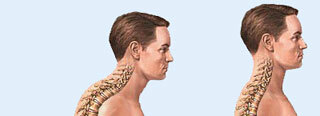
The neck is a much thinner place than the lower back due to the large number of conducting neural bundles concentrated in a small space. Therefore, the most common signs for lordosis of the cervical spine will be:
- A characteristic change in posture. With this, the shoulders fall down, the thorax flattenes, and the stomach begins to project forward. The neck is also pulled forward;
- Chronic pain syndrome in the neck and shoulder blades, aching pain in the shoulders and spine. An important sign of this pain is the muscle component: in lordosis, the neck muscles are constantly strained, so they spasmodic, due to the accumulation of lactic acid. Most often this occurs with osteochondrosis;
- Headaches, often rising up from the cervical spine;
- Functional disorders, such as memory loss, attention and disability, the appearance of tinnitus;
- Signs of sleep disorders, decreased appetite, possible association of pain in the neck with increased blood pressure;
- Attachment of focal neurological symptoms: decreased sensitivity in the hands, for example, at the fingertips, the appearance of a sensation of "crawling", a decrease in sensitivity in the hands and feet.
We should say a few words about the diagnosis of cervical lordosis. In classic cases, the diagnosis is made on the basis of characteristic complaints, as well as examination data and instrumental diagnostic methods, among which the leading role is played by the x-ray of the cervical spine with functional tests( in the position of maximum flexion and then extension of the neck).
Lumbar lordosis
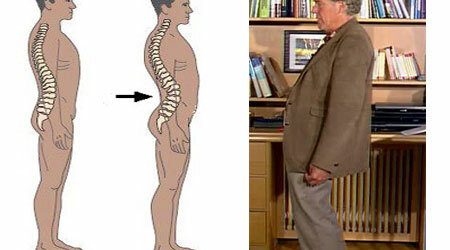
The lumbar spine of the lumbar spine is the "twin brother" of cervical lordosis, with only one characteristic circumstance: all vertebrae of the lumbar spine are more massive, so the disease is generally characterized by a more "rough" clinical picture.
As in the case of the cervical department, a physiological bend in this case is formed very early, when the baby learns to sit properly. First lumbar lordosis occurs as a mechanism to relieve the load from the spine.
Its apex in normal education occurs somewhere at the level of 3 or 4 lumbar vertebrae.
Pathological lumbar lordosis occurs when, for example, calcium deficiency occurs in a growing body. This is the main reason in the absence of organic symptoms.
As with cervical varieties of pathological lumbar lordosis, there are both primary and secondary forms of it.
The causes of lumbar lordosis are completely consistent with the causes of the development of the same disorder in the cervical spine. The smoothed lordosis of the lumbar spine may manifest as pain in the lower back, in the legs, change in posture.
Treatment of cervical and lumbar lordosis - drugs and methods
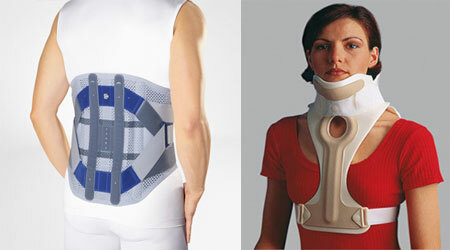
Treatment of lordosis of the cervical spine, like lumbar spine, has much in common. So, you need to start with non-drug correction methods of posture, gradually increasing the therapeutic effect. In case of an exacerbation, the appearance of severe pain syndrome, it is desirable to begin therapy in the first days with the administration of medications.
So, use the following tools:
- Non-steroidal anti-inflammatory drugs: meloxicam, ketotifen, ibuprofen in combination preparations;
- Analgesics( Ketanov, Zaldiar) with severe pain syndrome;
- Muscle relaxants of central action( Midokalm, Sirdalud) with pronounced muscular spasm;
- Multivitamin preparations, especially groups "B", mineral complexes containing calcium;
Non-drug therapies for the treatment of lordosis means getting out of an acute condition.
When achieving relief, or the phase of incomplete clinical remission, acupuncture, physiotherapy( UHF, Amplipulse), magnetotherapy, application of Lyapko applicators are used. On the neck are worn special collars Shants, which need to be selected in size.
An important stage is sanatorium treatment. Very good help to correct lordosis of the cervical spine underwater traction, shower - massage, balneological procedures, baths, including radon, complexes of therapeutic gymnastics.
Exceptionally good therapeutic and preventive action is provided by swimming, including with lumbar disorders.
In some cases, with severe disturbances and inefficiency of conservative treatment, surgery is indicated. Most often, an additional strengthening of the spine is created by installing metal implants for osteosynthesis.
Complications of lordosis
Both cervical and lumbar lordosis can cause a number of different complications, significantly weighting the course of the underlying disease. These include conditions such as the appearance of intracranial hypertension in cervical disorders, impaired sensitivity in the fingers, the emergence of focal neurological symptoms in the form of paresis and paralysis.
In the lumbar location, there may be radiculitis, signs of sciatica and compression neuropathies with a violation of the sensory and motor ways. Perhaps even a violation of the pelvic organs.
Prevention
Here it is hardly possible to report something fundamentally new. Like other disorders of the musculoskeletal system, violations of the physiological curves of the spine require an active lifestyle, normalization of body weight, proper nutrition, as well as the rejection of bad habits.
Good use of orthopedic pillows and mattresses, refusal of soft beds and regular exercises that strengthen the muscular framework of the spine.
For prophylaxis every 2 years, it is recommended to perform a radiograph of the cervical or lumbar spine in the presence of indications( pain, impaired function) for timely treatment.

